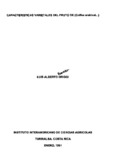Características varietales del fruto de Coffea arabica L

View/
Date
1961Author
Fournier Origgi, L.A.
Autor Corporativo
Instituto Interamericano de Ciencias Agrícolas (IICA)
xmlui.dri2xhtml.METS-1.0.item-location
Turrialba, Costa Rica
Type
Tesis
Metadata
Show full item recordDescription
Tesis (Mag. Sc.) -- IICA, Turrialba (Costa Rica),1961
Abstract
El fruto de Coffea arabica L. en la variedad 'Typica' muestra los siguientes trazos vasculares: a) haces del bipantio y el caliz; b) haces dorsales; c) haces funiculares y d) haces medulares. El crecimiento tanto del pericarpo como de la semilla se debe al inicio del desarrollo del fruto, a divisiones celulares y a expansión celular, pero en el último periodo predomina la expansión celular. El tejido que se desarrolla en la semilla durante los tres primeros meses de crecimiento es el integumento, poro luego éste es sustituido por el endosperma. Ente hecho coincida con el endurecimiento del endoscarpo y un rápido desarrollo del embrión. Las curvas de crecimiento de los frutos en cinco cultivares estudiados ('Typica, Bourbon, Leroy, Maragogipe y T-539) presentan una forma sigmoidea doble con tres períodos definidos de crecimiento. Lo mismo so observa en los frutos 'triángulo' y 'caracolillo'. Durante el segundo y tercer período es cuando se aprecian las mayores diferencias tanto entro las dimensiones de los frutos de los cultivares, como en la duración de estos períodos. Las diferencias entre las dimensiones evidencian las características morfológicas de los frutos en los cultivares. El desarrollo completo de la semilla no guarda siempre relación con la coloración externa del fruto. Los valores elevados de las razones entre la longitud y los dos anchos en el segundo periodo de crecimiento, son el resultado de un mayor alargamiento de los frutos en sentido de la longitud que a lo ancho. The fruit of Coffaa arabica var. Typica shows the following vascular traces: a) bundles of the bypantium and calyx; b) dorsal traces; c) funicular traces and medular traces. Growth of the pericarp and seed in due in the first period to cell division and expansion, predominating cell expansion in the last stages of development. During the first three months of the development the tissue that forms the seed corresponds to the integuments. Later on this tissue la substituted by the endosperm. This coincides with the hardening of the endocarp and a quick development of the embryo. The growth curves of normal fruits of the five cultivars studied (Typica, Bourbon, Leroy, Maragogipe and T-359) showed a doble sigmoid shape with three well defined periods of growth. The same was true for triangular and round beans, During the second and third periods great variability is observed among the fruit dimensions of the different cultivars, as well as in the duration of the periods. The differences in the dimensions give evidence of morphological features of the fruits of the cultivars. Full development of the seed is not necessarily correlated with the external colorations of the fruit. The high ratio values between longitude and the two widths, particularly during the second growth period, indicate the greater increase in length of the fruits. This may be due to a higher frequency of anticlinal cell divisions and to an irregular expansion of the cells.
Keywords
CARACTERISTICAS DE LAS PLANTAS, CRECIMIENTO DE FRUTOS, EFECTO DE LOS FACTORES AMBIENTALES EN LAS PLANTAS, FRUTOS ANORMALES, COSTA RICA, FRUIT, PLANT ANATOMY, CHEMICOPHYSICAL PROPERTIES, WEIGHT, VOLUME, DENSITYCOFFEA ARABICA, FRUTO, ANATOMIA DE LA PLANTA, PROPIEDADES FISICOQUIMICAS, PESO, VOLUMEN, DENSIDAD,
Publisher
Instituto Interamericano de Ciencias Agrícolas (IICA)
URI (Permanet link to cite or share this item)
https://repositorio.catie.ac.cr/handle/11554/622Collections
- Tesis [3077]

